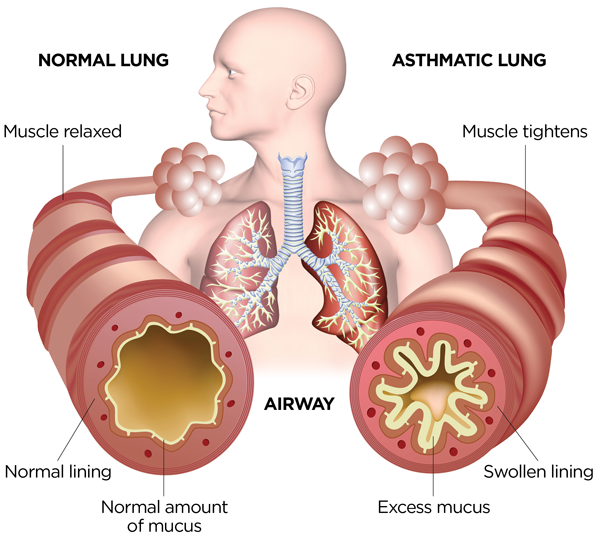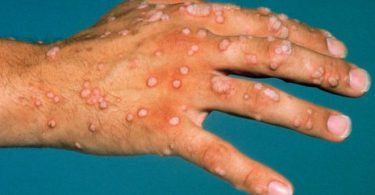
HOMOEOPATHIC MANAGEMENT
INTRODUCTION –Asthma is a chronic inflammatory disease of the airways that causes airway hyper-responsiveness, mucosal edema, and mucus production leading to symptoms of wheeze, cough, chest tightness and dyspnoea.
Asthma is a disorder of the bronchial airways characterized by period of reversible broncho spam. Asthma differs from the other obstructive lung diseases in that it is largely reversible, either spontaneously or with treatment.
.
Patients with asthma may experience symptom-free periods alternating with acute exacerbations, which last from minutes to hours or days.
The most frequent form has its onset in childhood between the ages of 3 and 5 years and may either worsen or improve during adolescence.
CLASSIFICATION
Asthma triggers can be classified into two categories –
- Allergic triggers
- Non-allergic triggers.
The allergic asthma triggers are as follows:
1. Dust Mites
Dust mites are insects that dwell in the corners of the house that are quite dusty. These insects can cause the immune system of the individual to overreact, thus resulting in the individual experiencing an asthma attack.
2. Cockroaches
Cockroaches are another insect that could result in the intensifying of the asthma symptoms. The shedding body parts of the insect, along with the faeces of the insect.
3. Pet Dander
Pet dander or the fur of pets can act as an asthma trigger and intensify the asthma symptoms leading to an asthma attack.
4. Mould
The mould that is present in the house can produce several allergens or toxic substances. When inhaled, these allergens can cause the hypersensitive airways to react negatively thus resulting in an asthma attack.
5. Smoke
Exposure to smoke of any kind (be it tobacco smoke, second-hand smoke, smoke caused by fire etc.) can irritate the airways of the person which could lead to the intensification of the asthma symptoms.
6. Perfume and Other Strong Odours
It is not uncommon for an asthma attacks to be triggered by different perfumes and strong fumes. This could be because of the particles that are released by the perfumes that could cause the airway of the individual to get irritated, resulting experiencing asthma attack.
The main non-allergic asthma trigger is exercise.
Exercise, if not did correctly or in moderation can trigger an asthma attack. Typically, it requires about 4 to 6 minutes of moderately severe or severe continuous exercise to provoke the symptoms of asthma.
SEVERITY OF ASTHMA
(A)Intermittent Asthma
For people suffering from intermittent asthma, the symptoms may usually occur fewer than two days a week, and there will be no difficulty in performing daily activities. Symptoms occurring at night can be rare. The spirometer and peak flow meter test will be 80% or more from the expected value and vary little normal when the person is not experiencing an asthma attack. The peak expiratory flow (PEF) varies less than 20% from morning to afternoon.
(B)Mild Persistent Asthma
If a person has persistent asthma, the symptoms will be experienced often and these flare-ups can affect the performance of daily activities. Experiencing asthma symptoms at night can happen 2 to 4 times a month. Persistent asthma is severe as compared to intermittent asthma. Lung function test results in 80% or more of the expected value and might vary slightly (PEF varies 20% to 30%) from morning to afternoon.
(C)Moderate Persistent Asthma
In this category, asthma symptoms will be experienced throughout the day. The night time symptoms occur more than once a week and flare-ups may interfere the performance of daily activities. The lung function test may result between 60% -80% of the expected result and the PEF varies more than 30% from morning to afternoon.
Severe Persistent Asthma
In severe persistent asthma, the symptoms can be experienced throughout the day, and it can be extremely difficult to carry out daily activities. The night time symptoms can almost occur every night. The lung function test would be abnormal, that is less than 60% of the expected result and PEF varies more than 30% from morning to evening.
TYPES OF ASTHMA:
There are 12 major types of asthma which can be classified based on the severity of asthma symptoms. The types of asthma are as follows:
1. Nocturnal Asthma
Nocturnal Asthma refers to the type of asthma where in the asthma symptoms get worse during the night-time. Night time asthma happens due to the activation of the parasympathetic system in the night time which causes bronchoconstriction. Frequent nocturnal symptoms are an indicator of poor asthma control.
2. Occupational Asthma
1 asthma case out of every 6 asthma cases is said to be occupational asthma. Industries that expose the workers to a number of irritants in large quantities put their employees at risk of developing occupational asthma. Within occupational asthma, inhaling high molecular weight proteins and low molecular weight chemicals are the main causes of the development of asthma.
3. Exercise-Induced Asthma
Severe hyperpnoea (increased rate and depth of breathing) in addition to exercise, diesel exhaust particles, nitro oxide, irritants and various other gases can result in hyper responsive airways which can lead to exercise-induced asthma. This type of asthma is mainly found in athletes and could also result in the injury of the epithelial caused due to poor breathing during long periods of strenuous exercise. The condition is usually also related to the dehydration of the airways.
4. Adult-Onset Asthma
Adult-Onset Asthma refers to the type of asthma where in the asthma symptoms appear at a later age, generally between the ages of 12 – 65 years. This type of asthma is characterized by a poor prognosis, a severe and persistent airflow limitation and a faster decline in lung function. The major causes of adult-onset asthma include workplace irritants, environmental pollutants; hormonal changes respiratory infections, upper airway diseases, obesity, aspirin and paracetamol intake and stressful life events.
5. Cough Variant Asthma
While the symptoms of asthma usually include coughing, wheezing, shortness of breath and a tight feeling in the chest, individuals with cough variant asthma tend to have coughing as their major symptom of asthma. They also tend to experience a lack other asthma symptoms such as dyspnoea, wheezing, and a tight feeling in the chest and instead have a heightening cough reflex sensitivity with an unproductive cough.
6. Aspirin-induced Asthma or Aspirin-Exacerbated Respiratory Disease
Aspirin-Exacerbated Respiratory Disease or AERD is a subtype of asthma that is manifested by a combination of adult-onset asthma, nasal polyposis, aspirin sensitivity and chronic rhino sinusitis. This type of asthma is experienced by 7% of the entire asthmatic population.
7. Obesity Induced Asthma
Obesity is a risk factor for asthma, which means that if a person is obese he or she has a higher risk than others to develop asthma. It plays a key role in the poor management of the condition. Recent studies have shown that weight gain and obesity tend to precede the condition, however, there is no proper conclusion drawn about how the two elements affect each other.
8. Neutrophilic Asthma
Neutrophilic Asthma is a type of asthma that is characterized by the excessive inflammation of the airways of the individual along with a disordered airway microbiome and an increase in the bacteria burden present in the airways. The presence of airway dysbiosis is what makes this type of asthma different from other types of asthma.
The types of asthma listed here can be overlapping due to the symptoms and their similar patterns. For example: Allergic asthma could have a nocturnal asthma component, which means a person suffering from allergic asthma can often experience worsening of symptoms at night and it might be difficult to classify this type of asthma.
SYMPTOMS
Diagnosis –
1-SPUTUM & BLOOD EXAMINATION -may show eosinophilia.
2–SERUM Ige LEVELS are raised in atopic asthma
3-CHEST X-RAY –may show increased translucency of the lungs due to overinflation.
4-ARTERIAL BLOOD GAS ANALYSIS -pao2 & paco2 are performed invariably inn asthma. respiratory alkalosis & an increase in the alveolar-arterial o2 difference are common. there is evidence of hypoxaemia during attack of asthma.
6-SPIROMETRY TEST – Spirogram may continue to rise for more than 6 seconds because lung take longer to empty.
7-PEAK FLOW METER -Airflow is reduced because the airways narrow and the FEV1 is reduced . Peak expiratory flow reduced so maximum height.
Airflow reduces rapidly with the reduction in the lung volumes because the airways narrow and the loop become concave.
Concavity may be the indicator of airflow obstruction and may present before the change in FEV1 or FEV1/FVC.
Management of Asthma
Inhalation therapy is the most effective way to treat asthma. However, both inhalation medication & oral medication is available for asthma treatment.
1. Inhalation Therapy – This treatment route makes use of different types of inhalers to effectively manage your symptoms. Inhaled route helps to deliver the medicines directly to the lungs, which shows impact on symptoms quicker as compared to other methods of delivering medicines. It includes use of asthma inhalers and a machine called nebuliser that helps asthmatics to inhale medicines easily.
2. Oral Treatment – Oral medication for asthma includes oral pills and syrups, has more side effects than inhaled medication, as a larger dose is used. Oral medications have a slower onset of action and their action is not specific to lungs.
HOMOEOPATHY MANAGEMENT
Homeopathy is a safe science that offers a permanent cure for asthma and helps remove asthma from the root. These medicines set off the body’s own restorative processes, mainly strengthening its natural healing system to make it strong enough to fight the condition. In case asthma is allergic in origin, these medicines start by treating the allergies causing asthma to completely uproot the disease. They are natural, safe and free from any adverse side-effects.
Homeopathic Medicines for Asthma
1. Arsenic Album -The symptoms indicative of use Arsenic Album are suffocative cough, wheezing, and shortness of breath. Asthma that gets worse around midnight is also treated well with this medicine. Another important guiding feature for using Arsenic Album is asthma that alternatives with skin rash or eczema.
2. Spongia Tosta – Spongia Tosta works well for asthma with a dry cough. The cough, in this case, can be deep, barking, hacking type. The cough is attended with extreme dryness of all the air passages. Along with dry cough, whistling from the chest on inspiration is noted. Respiration is also difficult. In most cases, warm drinks bring relief from the cough.
3. Antimonium Tartaricum – Antimonium Tartaricum is an excellent remedy for asthma with an excessive, rattling cough. The cough is loose, rattling and the lungs feel full of mucus. Mucus from the lungs is raised with much difficulty. Respiration is rapid and difficult. Excessive suffocation is observed. The suffocation worsens on lying down, with a need to sit up.
4. Ipecac–Ipecac and Sambucus Nigra help treat asthma in children. Ipecac works well when there is excessive cough with mucus rales in the chest. The cough is accompanied by suffocation, shortness of breath and gasping for air. The child may become blue and stiff during the asthma attack.
5-Sambucus Nigra-is indicated for night asthma episodes in children. A child in need of Sambucus Nigra wakes up suddenly at night, with cough and suffocation.
6. Dulcamara – Dulcamara is very useful natural remedies for asthma in damp weather. Among them, Dulcamara is the best prescription for loose, rattling asthmatic cough in damp weather where the person has to cough a long time to expel phlegm.
7- Natrum Sulphuricum – the most helpful medicine where cough with thick, ropy, green phlegm is present. Natrum Sulphuricum also works well where the asthma worsens around 4 am and 5 am. it is also among the top grade remedies for treating asthma in children.
6. Nux Vomica – Nux Vomica is a prominent remedy for asthma in the winter. Cough with wheezing and oppressed breathing arise in cold weather. The cough may be prominently dry in the evening and night time but loose with expectoration during the day. Suffocative asthma attacks after midnight are also best treated with Nux Vomica. Nux Vomica is also of great help in gastric asthma.
7. Blatta Orientalis
Blatta Orientalis is significant remedy for asthma triggered by exposure to dust. it is prescribed for a cough with difficult respiration and pus-like mucus.
8-Bromium –Bromium is selected when there is cough with the rattling of mucus, suffocation, and difficulty in breathing after exposure to dust.
9-Carbo Veg– Carbo Veg show the most amazing results in asthma in aged people. Carbo Veg is prescribed in case of cough with burning pain in the chest. Expectoration is present in the morning. The phlegm is mainly yellow or pus-like and has sour, salty or putrid taste. The cough gets worse in the evening. Wheezing and rattling of mucus are also prominent. Carbo Veg is also the medicine to use where the cough worsens as one goes from a warm place to a cold place. It is also the medicine to go to for treating asthma that worsens with acidity or flatulence.
10-Senega– it is considered where there is difficulty in raising mucus from the chest. The mucus is tough and profuse. Oppression, weight, and soreness are felt in the chest.
11-. Drosera Rotundifolia – The features guiding the use of Drosera Rotundifolia are a dry and highly irritating cough. The paroxysms of cough follow each other rapidly. Talking may worsen the cough. Rough, scraping sensation in the throat may attend along with a nocturnal cough.
12-Coccus Cacti -it indicated where cough with much suffocation and strangling sensation in the throat predominates. Coccus Cacti also works well for a spasmodic cough that ends in vomiting.
13-. Lobelia Inflata – Lobelia Inflata is a very useful medicine for treating asthma in smokers. The person needing Lobelia Inflata has difficult, short respiration with cough. He complains of oppressed feeling in the chest. He feels like there’s a lump in the throat. Few persons who need Lobelia Inflata also complain of a burning sensation in the chest.
RUBRICS FROM DIFFERENT REPERTORY
PHATAK REPERTORY
ASTHMA, CARDIAC (SEE RESPIRATION DIFFICULT) (7)
ASTHMA, EXPECTORATION > (6)
ASTHMA, OLD PEOPLE IN (7)
ASTHMA, WINTER < (3)
ASTHMA, THUNDERSTORM DURING (4)
RESPIRATION, WHISTLING, HISSING WHEEZING (12)
CHEST & LUNGS, TIGHT, LEFT (4)
CHEST & LUNGS, TIGHT, RIGHT (3)
CORYZA, DYSPNOEA WITH (3)
SWEAT, DYSPNOEA, WITH (2)
DIFFICULT, BREATHING HANDKERCHIEF, CANNOT BEAR TO HAVE, APPROACH THE MOUTH AS IT WILL CAUSE DYSPNEA(4)
DISCOLORATION, BLUISH DYSPNEA, WITH (3)
MURPHY REPERTORY
ASTHMA, CHILDREN (29)
ELDERLY, PEOPLE ASTHMA (19)
ASTHMA, ANGER, AFTER (6)
ASTHMA, DAMPNESS, FROM (6)
ASTHMA, EXCITEMENT (23)
ASTHMA, GASTRIC DERANGEMENTS, WITH (12)
ASTHMA, HUMID (19)
ASTHMA, MIDNIGHT, AFTER (8)
ASTHMA, PERIODIC (18)
WHEEZING, INSPIRING, WHILE (5)
WHEEZING, EXPIRING, WHEN (3)
ACHING, PAIN TIGHTNESS IN CHEST, WITH, BETTER ERUCTATIONS (2)
COMPLETE REPERTORY
ANXIETY ASTHMA, WITH (8)
CORYZA GENERAL ASTHMA, WITH (11)
CHOKING, CONSTRICTING ASTHMA, WITH (5)
FAINTNESS, FAINTING GENERAL ASTHMA, FROM (6)
Author :- Dr. Niharika Jain ,MD (Scholar)
Department of Practice Of Medicine , GHMC ,Bhopal , MP
Email: [email protected]
Co-Author :-
Dr. Neeta Jain, MD (Medicine)
Founder of Prabha Multi speciality Homoeopathic clinic, Indore, MP
Email: [email protected]









